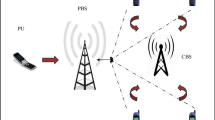Abstract
Non-contiguous orthogonal frequency division multiplexing is considered as an auspicious scheme for the cognitive radio (CR) systems. It has the abilities such as spectral efficiency, multiple path delay spread and robustness against channel fading. However, due to its high sidelobes, it distorts the signals of the neighboring users including cognitive radio users (CRUs) as well as licensed users. In this paper, we proposed two novel metaheuristic algorithms, i.e., Cuckoo search algorithm and Firefly algorithm, to estimate the amplitudes of cancelation carriers which are used for the suppression of sidelobes. The effectiveness of the proposed algorithms is shown in single as well as the multiple CRUs environment. Simulations results in terms of power spectral density show that with the help of proposed algorithms significant reduction in sidelobes is achieved as compared with the existing methods.
















Similar content being viewed by others
Explore related subjects
Discover the latest articles, news and stories from top researchers in related subjects.References
Mitola J III, Maguire GQ Jr (1999) Cognitive radio: making software radios more personal. Pers Commun IEEE 6(4):13–18
Proakis JG, Salehi M (2008) Salehi digital communications. McGraw-Hill, New York
Goldsmith A (2005) Wireless communications. Cambridge University Press, Cambridge
El-Saadany MS, Shalash AF, Abdallah M (2009) Revisiting active cancellation carriers for shaping the spectrum of OFDM-based cognitive radios. In: Sarnoff symposium, 2009. SARNOFF’09. IEEE, pp 1–5
Sahin A, Arslan H (2011) Edge windowing for OFDM based systems. Commun Lett IEEE 15(11):1208–1211
Noguet D, Gautier M, Berg V (2011) Advances in opportunistic radio technologies for TVWS. EURASIP J Wirel Commun Netw 2011(1):1–12
Brandes S, Cosovic I, Schnell M (2005) Sidelobe suppression in OFDM systems by insertion of cancellation carriers. In: Vehicular technology conference, 2005. VTC-2005-Fall. 2005 IEEE 62nd, vol 1, pp 152–156
Pagadarai S, Wyglinski AM, Rajbanshi R (2008) A sub-optimal sidelobe suppression technique for OFDM-based cognitive radios. In: Military communications conference, 2008. MILCOM 2008. IEEE, pp 1–6
Lopes FRB, Panaro JSG (2013) OFDM sidelobe suppression combining active and null cancellation carriers in the guard bands. In: Microwave and optoelectronics conference (IMOC), 2013 SBMO/IEEE MTT-S International, pp 1–5
Elahi A, Qureshi IM, Zaman F, Munir F (2016) Reduction of out of band radiation in non-contiguous OFDM based cognitive radio system using heuristic techniques. J Inf Sci Eng 32(2):349–364
Cosovic I, Brandes S, Schnell M (2006) Subcarrier weighting: a method for sidelobe suppression in OFDM systems. Commun Lett IEEE 10(6):444–446
Selim A, Macaluso I, Doyle L (2013) Efficient sidelobe suppression for OFDM systems using advanced cancellation carriers. In: 2013 IEEE international conference on communications (ICC), pp 4687–4692
Selim A, Doyle L (2013) Real-time sidelobe suppression for OFDM systems using advanced subcarrier weighting. In: Wireless communications and networking conference (WCNC), 2013 IEEE, pp 4043–4047
Pagadarai S, Rajbanshi R, Wyglinski AM, Minden GJ (2008) Sidelobe suppression for OFDM-based cognitive radios using constellation expansion. In: Wireless communications and networking conference, 2008. WCNC 2008. IEEE, pp 888–893
Li D, Dai X, Zhang H (2009) Sidelobe suppression in NC-OFDM systems using constellation adjustment. Commun Lett IEEE 13(5):327–329
Cosovic I, Mazzoni T (2006) Suppression of sidelobes in OFDM systems by multiple-choice sequences. Eur Trans Telecommun 17(6):623–630
Arqub OA, Al-Smadi M, Momani S, Hayat T (2017) Application of reproducing kernel algorithm for solving second-order, two-point fuzzy boundary value problems. Soft Comput 21(23):7191–7206
Arqub OA (2017) Adaptation of reproducing kernel algorithm for solving fuzzy Fredholm–Volterra integrodifferential equations. Neural Comput Appl 28(7):1591–1610
Arqub OA, Abo-Hammour Z (2014) Numerical solution of systems of second-order boundary value problems using continuous genetic algorithm. Inf Sci (NY) 279:396–415
Goldberg DE (1993) Genetic algorithms in search optimization and machine learning. Addison Wesley, Reading
Roberge V, Tarbouchi M, Labonté G (2013) Comparison of parallel genetic algorithm and particle swarm optimization for real-time UAV path planning. IEEE Trans Ind Inform 9(1):132–141
Tosun Ö (2014) Cuckoo search algorithm. In: Encyclopedia of business analytics and optimization. IGI Global, pp 558–564
Payne RB, Sorenson MD, Klitz K (2005) The cuckoos, vol. 15. Oxford University Press, Oxford
Gandomi AH, Yang X-S, Talatahari S, Alavi AH (2013) Firefly algorithm with chaos. Commun Nonlinear Sci Numer Simul 18(1):89–98
Fister I, Yang X-S, Brest J (2013) A comprehensive review of firefly algorithms. Swarm Evol Comput 13:34–46
Storn R, Price K (1997) Differential evolution—a simple and efficient heuristic for global optimization over continuous spaces. J Glob Optim 11(4):341–359
Price K, Storn RM, Lampinen JA (2006) Differential evolution: a practical approach to global optimization. Springer, New York
Gandomi AH, Yang X-S, Alavi AH (2013) Cuckoo search algorithm: a metaheuristic approach to solve structural optimization problems. Eng Comput 29(1):17–35
Yang X-S (2010) Firefly algorithm, stochastic test functions and design optimisation. Int J Bio Inspired Comput 2(2):78–84
Yang X-S (2010) Firefly algorithm, Levy flights and global optimization. In: Research and development in intelligent systems XXVI. Springer, pp 209–218
Author information
Authors and Affiliations
Corresponding author
Ethics declarations
Conflict of interest
The authors declare that they have no conflict of interest.
Rights and permissions
About this article
Cite this article
Elahi, A., Qureshi, I.M., Khan, S.U. et al. Improved algorithms for interference suppression in non-contiguous orthogonal frequency division multiplexing-based cognitive radio systems. Neural Comput & Applic 31, 3729–3741 (2019). https://doi.org/10.1007/s00521-017-3310-3
Received:
Accepted:
Published:
Issue Date:
DOI: https://doi.org/10.1007/s00521-017-3310-3




